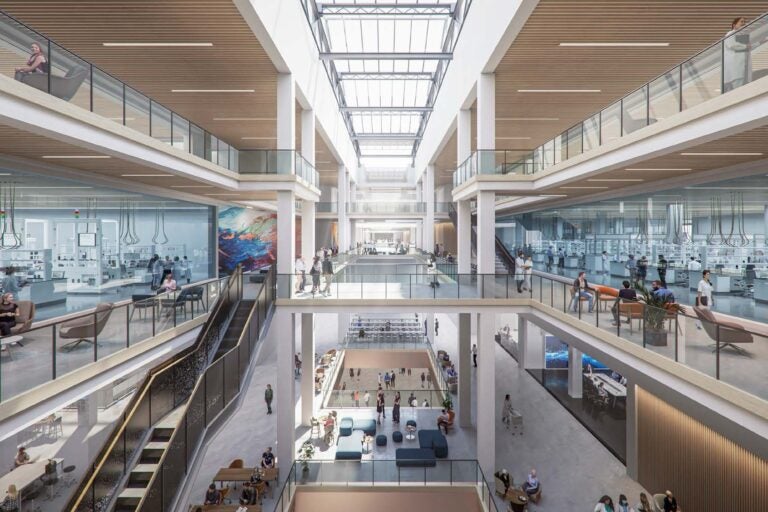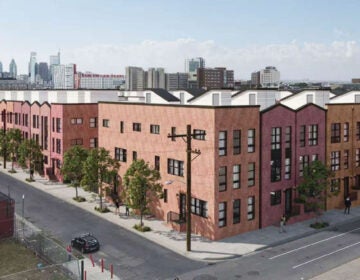What’s next for Philly’s Fashion District in Center City? Here’s what we know
Comcast Spectacor’s vision was shared with the Washington Square West Civic Association board as a Sixers arena alternative for Market East revitalization.

About one-third of the Fashion District, formerly known as the Gallery in Center City, may be demolished for a future 76ers NBA team arena. The Fashion District entrance on Market Street shown in fall 2023. (Adam Staniszewski)
Have a question about Philly’s neighborhoods or the systems that shape them? PlanPhilly reporters want to hear from you! Ask us a question or send us a story idea you think we should cover.
Tami Sortman, president of the Washington Square West Civic Association, has lived in the neighborhood since the late 1990s. That means she shopped with Center City Philadelphia retailers when it was known as the Gallery, as well as after its renovation into the Fashion District.
It also means she watched the indoor mall struggle despite a $350 million facelift and the subsequent bankruptcy of a key business partner. Developers once promised the retrofitted mall would generate nearly $200 million in new tax revenues over 20 years while bringing thousands of jobs in exchange for $90 million in subsidies. But “it never turned into what it was supposed to be because COVID hit,” Sortman told WHYY News.
She wasn’t the leader of her local community organization that could influence commercial development on Market East until three years ago. The volunteer board meets regularly with real estate developers who have plans that could affect the neighborhood, like buildings that have been under construction for years several doors down from historic rowhomes.
“We’re eager to learn more about projects and investments that enhance the economic viability of our neighborhood and Center City,” Sortman said. She praised projects like the Honickman Center by Jefferson Health as one way to revitalize pedestrian spaces and bring both people and jobs to the community. “But it’s only one block,” she said.
In August, representatives of Comcast Spectacor approached the Washington Square West Civic Association board about an idea as an alternative to a plan for a new NBA basketball arena for redevelopment on Market Street east of City Hall, Sortman said. The board agreed to a closed-door meeting to hear them out, just like it did when approached repeatedly by representatives of the Sixers about arena plans on the same footprint, she said.
“We have open [board] meetings all the time. If there is an organization that wants to come and speak to us about anything, [as] the board, we are open to it. I have an open-door policy,” she said.
So she’s been confused about why Comcast’s “vision” for the Fashion District floated to her has been interpreted as a controversial move.
“I’m not sure why our meeting was such an explosive thing when it was presented to the city, then it was presented to Chinatown, and we’re the third group they presented to,” she said. “They brought it to us saying, ‘Here’s an idea.’ This is just an idea, that’s it. It was a big kind of dump of information to us. There wasn’t any major deep dive. They didn’t get into those logistics of zoning.”
Neither the Philadelphia Chinatown Development Corporation, the city of Philadelphia nor Mayor Cherelle Parker’s administration responded to fact-checking by WHYY News regarding the Comcast Spectacor idea for Market East. But Councilmember Mark Squilla, who represents the area, replied that he got a copy of the Comcast presentation.
As of Sept. 6, the civic association’s board has endorsed neither the Comcast vision nor the Sixers’ arena proposal.
“Our community has spoken out about it for sure. All the statistics that we put together in regards to questionnaires we sent out to our neighbors, overwhelmingly right now, they have been against the arena,” she said. “But the board, ourselves, have not spoken out. We’re just digesting all of this information that just came out.”
That means the board is still reading the arena studies, which are hundreds of pages long each.
Comcast Spectacor sent Todd Glickman, its chief revenue officer and government affairs chief, to the meeting, and hired architect William McDowell, Sortman said.
Here’s what Comcast Spectacor pitched: a verbal presentation with several graphic renderings about what’s possible if the Sixers kill their standalone Market East arena idea and stay at Wells Fargo Center. It would include a biomedical hub inside the less popular section of the Fashion District.
Comcast Spectacor declined a news interview with a representative authorized to speak to the media, but did submit a statement.
“Our hope is that the 76ers will remain in South Philadelphia as a partner in the Wells Fargo Center,” said Dan Hilferty, chairman and CEO of Comcast Spectacor in a statement. “We continue to offer the 76ers a 50/50 partnership. This includes the opportunity to build a new arena, on an accelerated timeline.”
In response to questions about the verbal presentation with renderings, Comcast Spectacor described that any development is not competitive with the arena but would only move forward if “the 76ers decide to stay in South Philadelphia,” because the company “also recognizes the need to revitalize Market East.”
Ultimately, Hilferty said that the company “felt a responsibility to share an alternative solution that creates benefits for all community members and enhances Philadelphia’s vibrant downtown.”
So what was the general vibe after the meeting in late August?
“Having a building that is a medical science building seemed to be not a bad idea. My concern was what would happen on the Market East side. Because that’s our side and our side is full of empty storefronts,” said Sortman. “The board felt it was not a bad idea. But I can’t speak [for] every board member.”
It’s unclear how realistic Comcast Spectacor’s current vision would be.
As it stands, the Fashion District is owned, operated and its debt has been paid off by Macerich, a Santa Monica, California-based real estate business.
Neither the company nor the Sixers would confirm that a previously announced purchase agreement for roughly one-third of the Fashion District was still under contract.
The Sixers did not respond to comment for this story.
In December 2023, the Fashion District had an occupancy rate of 80% — which means 20% of the stores don’t have active retail tenant leases.
“We have not been approached by Comcast regarding [the] Fashion District,” said Kurt Ivey, senior vice president of marketing at Macerich, in a recent email. “We can tell you, we are very excited to be working with the Sixers on their new arena.”
About the Fashion District mall debt: Macerich was on the hook for 100% of the mortgage owed due in January 2024 after Philadelphia-based PREIT filed for bankruptcy and sold its stake. The mall renovation debt had a floating interest rate instead of a fixed percentage, meaning in a high-interest-rate environment, the company has to repay more money. In April 2024, Macerich repaid the last chunk of that mortgage — $8.1 million, according to U.S. Securities and Exchange Commission records.
But Sortman isn’t hyper-focused on Comcast Spectacor versus the Sixers. She just wants to see a cohesive vision for all property owners in the Market East commercial corridor.
“Here’s my thing: We’ve got City Hall on one end. We’ve got the historic district on the other, and then [we’ve] got a bridge that connects the two. That is broken right now,” she said.
She floated various ideas of a satellite destination store for Hershey’s, M&M’s, Peanut Chews, Peeps and Herr’s potato chips that would be a homegrown Pennsylvania landmark and tourist attraction. But she’s never gotten the chance to share any of those ideas with economic development leaders at the city or business districts.
“Why aren’t we capitalizing on our own industries here in this market in Philadelphia?”
So far, the only city entity the group has collaborated with closely has been the Streets Department. She chalked that reality up to new leadership “all getting their feet wet right now,” but that she’s excited to dig in with “awesome women leaders.”
“I’ve got vacant spaces all over the neighborhood that have been vacant since I’ve lived here,” she said.
And she’s got ideas about how to insert art and temporary history installations to replace papered window storefronts.
“How do I get window graphics to be put in these buildings for now?” she said. “But to try and even get ahold of these organizations to ask them for that permission — to do that is so much work. And it shouldn’t be.”
Editor’s note: This story has been updated to accurately reflect the Fashion District occupancy rate.

Subscribe to PlanPhilly
WHYY is your source for fact-based, in-depth journalism and information. As a nonprofit organization, we rely on financial support from readers like you. Please give today.













